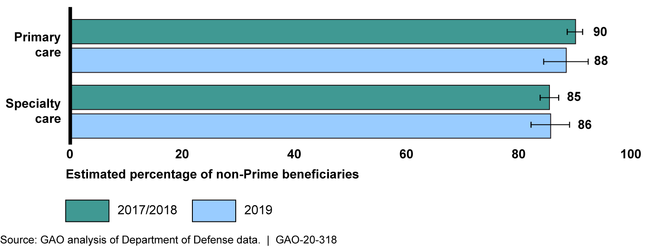Defense Health Care: DOD Surveys Indicate Beneficiary Experience Generally Unchanged in First Year of TRICARE Select
Fast Facts
More than 9 million active-duty military servicemembers and their families rely on TRICARE health plans. In January 2018, the Department of Defense offered a new plan—TRICARE Select—for beneficiaries who primarily get care from civilian doctors.
We looked at beneficiary surveys from before and after the new plan. These survey results were similar after the switch to TRICARE Select. However, more beneficiaries reported problems finding some types of civilian doctors who accepted TRICARE after the switch.

Doctor and patient
Highlights
What GAO Found
On January 1, 2018, the Department of Defense (DOD) implemented a new health plan option—TRICARE Select—for beneficiaries who primarily obtain care from civilian providers rather than through TRICARE's managed care plan—TRICARE Prime. DOD surveys indicate few changes in these non-Prime beneficiaries' satisfaction and access to care during the first year following the implementation of TRICARE Select, though GAO cannot directly attribute these differences to implementation due, in part, to other changes in the TRICARE program during the same time frame. Specifically, GAO found the following:
There was no change in the percent of beneficiaries reporting positive ratings of their TRICARE health care and health plans—80 percent and 68 percent, respectively—in the first year of TRICARE Select.
There was an increase in the percent of beneficiaries reporting problems accessing specialty providers from 18 to 24 percent in the first year of TRICARE Select. However, as the figure shows, there was no statistically significant change in the percent of beneficiaries reporting they received care as soon as needed for primary and specialty care appointments.
Non-Prime TRICARE Beneficiaries Who Reported Obtaining Appointments as Soon as Needed, 2017/2018 and 2019 Surveys

Notes: The Department of Defense surveys of beneficiaries who do not participate in TRICARE's managed care plan—non-Prime beneficiaries—present data from before (2017 and 2018 combined) and after (2019) implementation of TRICARE Select. GAO considered respondents to have obtained appointments when needed if they answered “usually” or “always” to questions that asked: In the last 12 months, how often did you (1) get an appointment for a check-up or routine care at a doctor's office or clinic (i.e., primary care) as soon as you needed, or (2) get an appointment to see a specialist (i.e., specialty care) as soon as you needed?
Error bars display 95 percent confidence levels for estimates, rounded to a whole number. Differences between the 2017/2018 and 2019 surveys are not statistically significant.
There was no change in the percent of providers that reported accepting new TRICARE patients if they were also accepting any new patients—about 90 percent of primary care and specialty care providers, and 47 percent of mental health care providers—in the first year of TRICARE Select.
Why GAO Did This Study
DOD provided health care to more than 9 million eligible beneficiaries through TRICARE in fiscal year 2018. Most of these beneficiaries were enrolled in TRICARE's managed care plan—TRICARE Prime. However, about 2 million beneficiaries received care primarily from civilian providers through TRICARE's non-Prime options: TRICARE Standard and Extra. Effective January 1, 2018, these two options were eliminated and TRICARE Select was implemented. TRICARE Select has similar benefits for provider choice and obtaining care from civilian providers as TRICARE Standard and Extra, but includes access standards to ensure at least 85 percent of enrollees are covered by TRICARE's network of civilian providers, among other things.
The National Defense Authorization Act (NDAA) for Fiscal Year 2008 included a provision for GAO to review results of DOD surveys of non-Prime beneficiaries and civilian providers. Additionally, the NDAA for Fiscal Year 2017 included a provision for GAO to review access to care after implementation of TRICARE Select in 2018. This report addresses both provisions.
GAO analyzed DOD's survey results to determine changes after implementation of TRICARE Select in (1) non-Prime beneficiaries' ratings of TRICARE, (2) non-Prime beneficiaries' reported ability to find providers and obtain appointments, and (3) civilian providers' reported acceptance of TRICARE. GAO analyzed the results of the 2017-2019 surveys, and interviewed agency officials and DOD contractors.
DOD provided technical comments, which GAO incorporated as appropriate.
For more information, contact James Cosgrove at (202) 512-7114 or cosgrovej@gao.gov.
